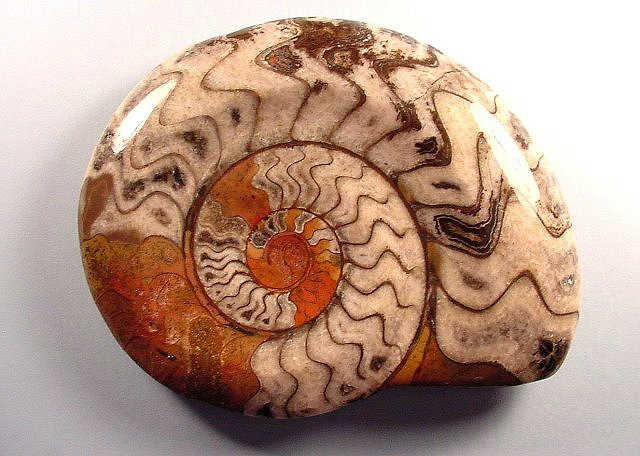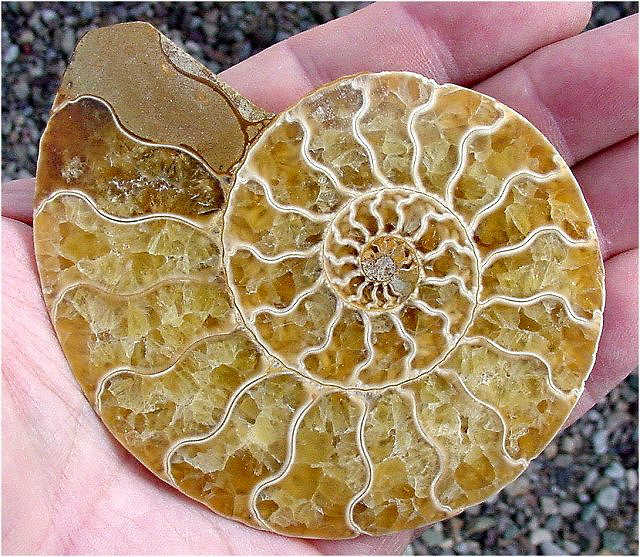The name Ammonite comes from the Greek ram-horn God called Ammon. Ammonites are the most widely known fossil; they are cephalopods and first appeared in the seas 415 million years ago, in the form of a straight shelled creature known as Bacrites. During their evolution three catastrophic events occurred. The first during the Permian period (250million years ago), only 10% survived. They went on to flourish throughout the Triassic period, but at the end of this period (206 million years ago) all but one species died. Then they began to thrive from the Jurassic period until the end of the Cretaceous period when all species of ammonites became extinct.



Ammonite fossils are found on every continent. And come in every naturally occurring color. Because of their rapid evolution and wide spread distribution they are an excellent tool for indexing and dating rocks. If an ammonite is found in clay the clay will preserve the Ammonites mother-of-pearl luster.
Ammonites began life very tiny, less then 1mm in diameter, and were vulnerable to attack from predators. They fed on plankton and quickly assumed a strong protective outer shell. They also grew quickly with the females growing up to 400% larger then the males; because they needed the larger shell for egg production. Most ammonites only lived for two years. Some lived longer becoming very large. The largest ever found was in Germany (6.5 feet in diameter).
Ammonites lived in shallow waters of 100 meters or less. They moved through the water by jet propulsion expelling water through a funnel like opening to propel themselves in the opposite direction. They were predators (cephalopods) feeding on most living marine life including mollusks, fish even other cephalopods. Ammonites would silently stalk their prey then quickly extend their tentacles to grab it. When caught the prey would be devoured by the Ammonites jaws located at the base of the tentacles between the eyes.
Shell Structure
Most ammonites have coiled shells. The chambered part of the shell is called a phragmocone. It contains a series of progressively layered chambers called camerae, which were divided by thin walls called septae. The last chamber is the body chamber. As the ammonite grew, it added new and larger chambers to the opened end of the shell. A thin living tube called a siphuncle passed through the septa, extending from the body to the empty shell chambers. This allowed the ammonite to empty water out of the shell chambers by hyperosmotic active transport process. This process controlled the buoyancy of the ammonite's shell.
Suture Patterns
Some Ammonites have intricate patterns on their shells called sutures. The different suture patterns tell us what time period the Ammonite is from.
Geometric = numerous undivided lobs and saddles; eight lobes around the conch is characteristic of the Paleozoic Ammonites.
Ceratitic = lobes have subdivided tips; giving them a saw-toothed appearance and rounded undivided saddles; Characteristic of the Triassic Ammonites.
Ammonitic = lobes and saddles are fluted; subdivisions are usually rounded instead of saw-toothed. This pattern is characteristic of the Jurassic and cretaceous Ammonites.
Classification
Kingdom: Animalia
Phylum: Mollusca
Class: Cephalopoda
Subclass: Ammonoidea
Trivia
During medieval times ammonites were believed to be petrified snakes. They were fitted with carved heads and sold to pilgrims.
The original discus used by the ancient Greeks in their Olympics was a fossilized ammonite!
In India ammonite fossils are identified with the god Vishnu and are used in various ceremonies.
The Navajo and Indians of the North American Plains carried ammonites in their medicine bags for health and good hunting. They called the ammonites buffalo stones because of their resemblance to the North American bison.
Chambered Nautilus
The name comes from the Greek nautilus meaning sailor. The chambered nautilus is believed to be the closest living relative to the ammonites. During prehistoric times there were 10,000 different species of nautilus, but only two different species survive today The Belauensis and Pompilius. The nautilus has a lot of value as a key to processes that shaped life in the ancient seas. They haven’t changed much in 500 million years so; they are considered “living fossils”.
Habitat
The chambered nautilus lives in the Indian Ocean and the tropical western Pacific Ocean; during the day they are at depths of 1800 feet. At night they rise and travel to coral reefs to feed; they eat crustaceans. When swimming the nautilus can reach speeds over two knots.
Differences
Their shells are made of mantle tissue and closely resemble the ammonites shell with some differences.
The siphuncle; in ammonites the siphuncle is inside the outer axis of the shell. In the Nautilus it runs through the center of the septa and camerae.
Ammonites were able to go inside their shells and close the opening. By closing a plate called the aptychus to protect it from other predators. The Nautilus has a leathery head shield called a hood to protect them when they go inside their shells. The Nautilus also, has the ability to camouflage itself. If you look down from the top, the shells coloration blends in with the darkness below. If you look from underneath, the shell is almost completely white blending in with the light from above. The Nautilus also has poor vision. Even though the eye structure is highly developed; they don’t have a solid lens instead they have a pinhole lens that water can pass through.
Ammonites have 26 chambers. Nautilus have 30 chambers are 8 to 10 inches long and have anywhere from 38 to 90 tentacles.
Reproduction
The female nautilus known as macroconch has the larger shell because it is required for egg production. The male is known as microconch. They migrate to shallow warm waters to reproduce. The male holds on to the females shell with his tentacles during mating, and transfers an elaborate packet of sperm into her mantle cavity with a specially modified arm. Eggs are laid one at a time, packaged in several layers of membranes that form a leathery protective capsule. The female attaches the capsule to a hard surface, such as rock or coral, with her arms. The babies are hatched with a shell that has four to seven chambers and are about 1 inch long. They will drift and feed on plankton as they grow.
Classification
Kingdom: Animalia
Phylum: Mollusca
Class: Cephalopodia
Subclass: Nautiladia
Order: Tetrabranchia
Family: Nautilodia
Genus: Nautilus
Species: Belauensis and Pompilius
Relatives
Close relatives of the chambered nautilus are the octopus, squid and cuttlefish. A distant relative is the snail.
Ammolite Gems
Fossilization Process
Ammonites were preyed upon by mosasaurs and other marine reptiles. The reptiles sank peg- like teeth into their shells extracting their squid shaped bodies to eat. The empty shell then sank to the sea floor, and was then buried in mineral rich sediment. During the fossilization process the sediment preserved the shell and enhanced the colors; to iridescent greens, reds, yellows and rare blues and violets.
In 1981 the International Colored Gemstone Commission recognized ammolite as a new organic gemstone. It is the rarest gemstone in the world. Only 1 out of 100 ammonite specimens is usable as ammolite. The ammolite fossils can be found in museums worldwide and range in size from 20 inches in diameter to 6 feet in diameter. Because ammolite isn’t very hard it must be treated like a pearl or opal.
Korite Mine
The only source of ammolite is the Korite mine in Alberta Canada. The mine is a pit about 25 feet deep on 6000 acres of rented land. Because of governmental regulations Korite can only operate one pit at a time. They also, must fill in each pit when they are done with it and replace the topsoil. The supply of ammolite is expected to last 60 years.
Markets
Japan is the primary market for the gemstones, with Canada and the Southern and Midwestern United States as secondary markets.
Specifications
Mineral composition of nacreous layer: aragonite (96.92%), strontium (0.48%), iron (1%), silicon (1%) and titanium (0.6%); With trace elements each of aluminum, barium, chromium, copper, magnesium, manganese and vanadium. Heating shows the mineral to be 0.44% water.
Refractive index: 1.52to1.58 birefringence
Specific Gravity: 2.70
Hardness: # 4 on Mohs scale of hardness.
Source: The only source is the Korite mine in Alberta Canada.
Works citied
Discovering Fossils
http://www.discovering fossils.co.uk/Ammonites.html
Wikipedia, the free encyclopedia
http://en.wikipedia.org/wiki/Ammonite
Canada Fossils: Ammonite
http://www.canadafossils.com/ammonites.html
MSN Encarta Premium-multimedia-Ammonite Fossil
http://encarta.msn.com/media_461527206/Ammonite_Fossil.html
Nautilus- Wikipedia, the free encyclopedia
http://en.wikipedia.org/wiki/Nautilus
Marine Life Profiles Waikiki Aquarium
http://waquarium.otted.hawaii:edu/mlp/root/html/Marine/ Life/Invertebrates/Molluscs/Nau…
Sea and Sky: Chambered Nautilus
http://www.seasky.org/monsters/sea7a1k-html
Ammolite
http://www.penoir.com/stones/Ammol.html
All photographs of Ammonite Fossils and Ammolite Gems courtesy of Mr. Roger Weller/ Cochise College